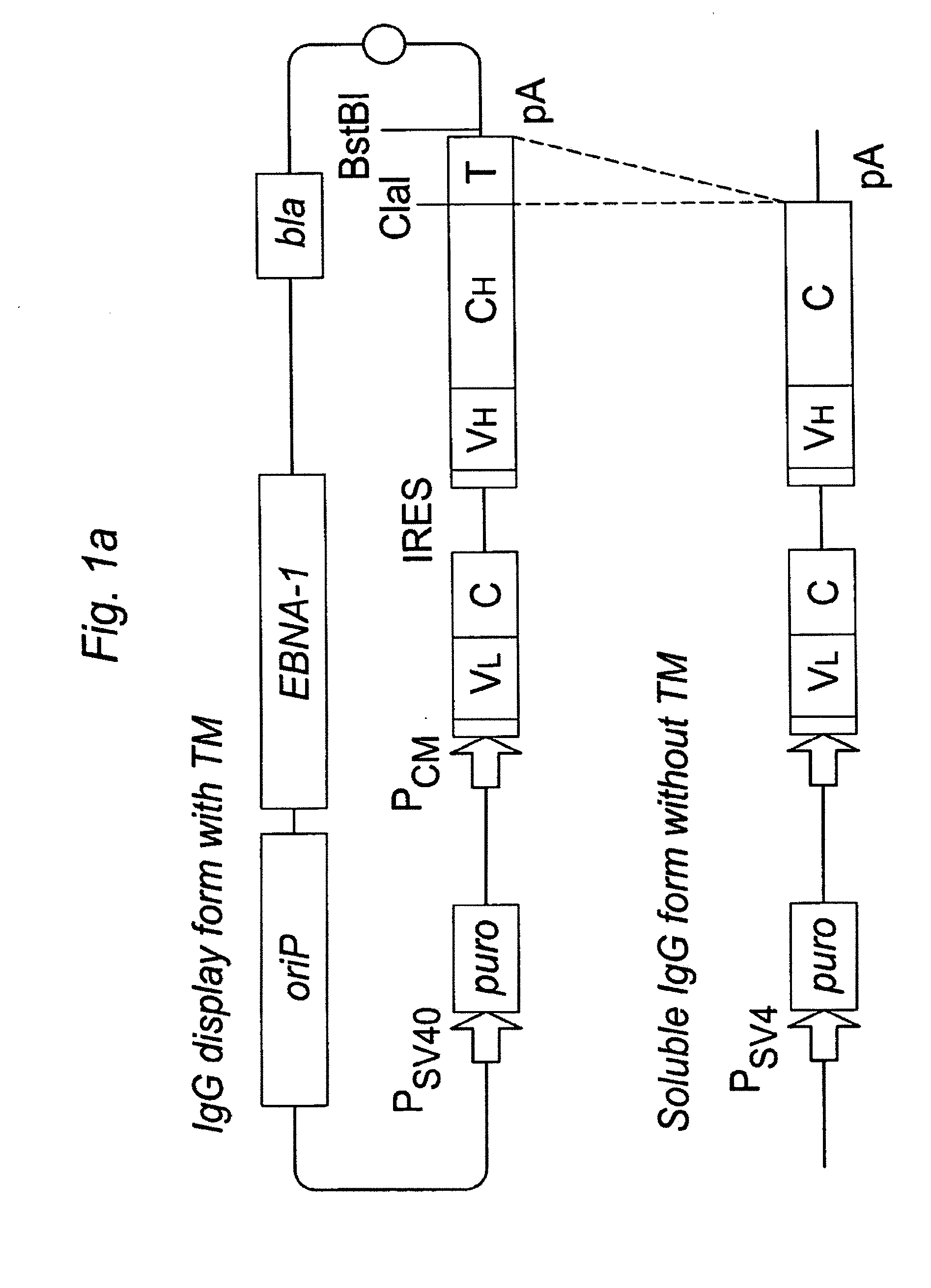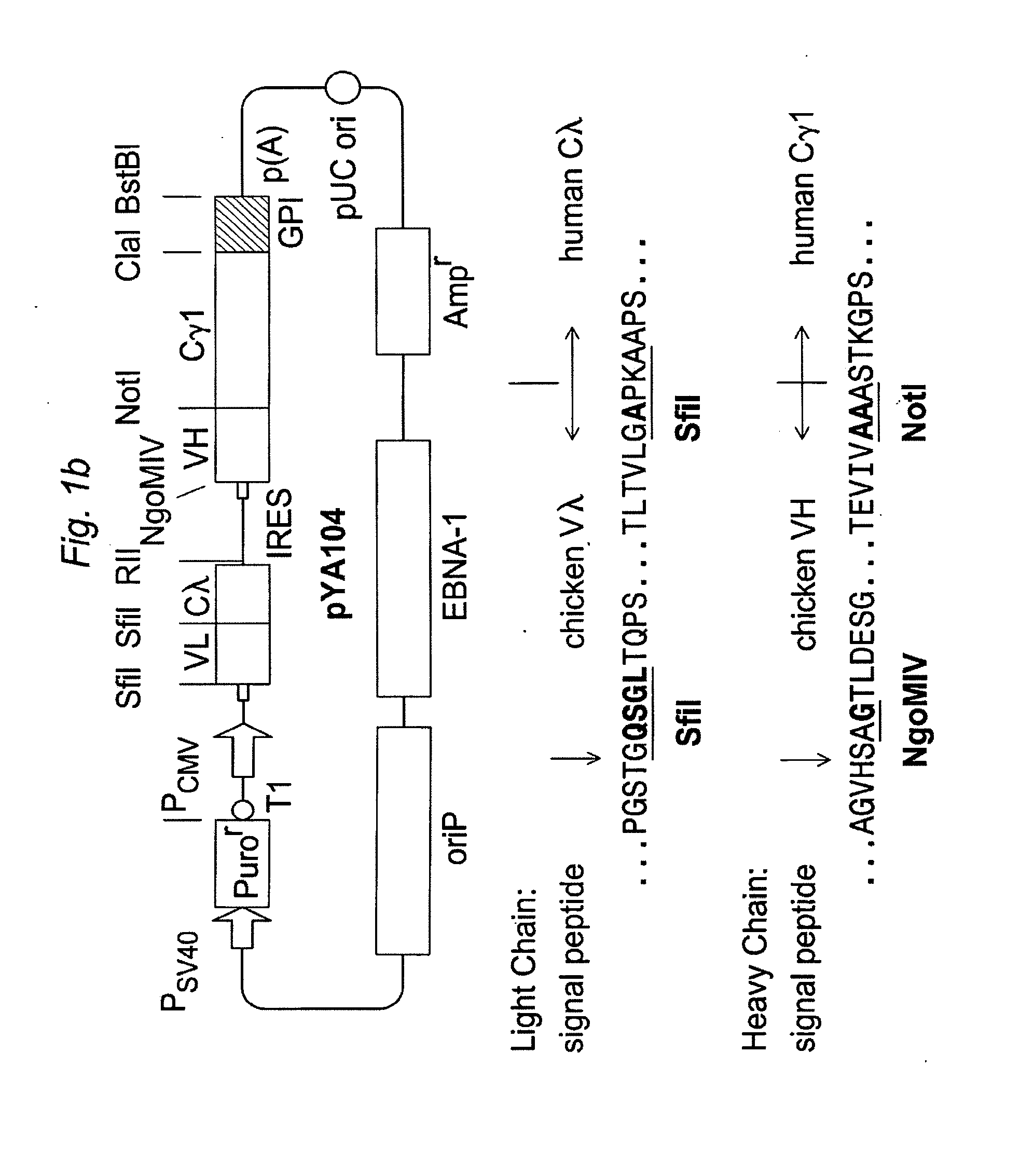Mammalian cell-based immunoglobulin display libraries
a cell-based immunoglobulin and display library technology, applied in the field of hybridoma technology, can solve the problems of difficult to raise high affinity antibodies, difficult to identify monoclonal antibodies that possess the desired binding and functional characteristics, and difficult to achieve high affinity antibodies. , to achieve the effect of easy and rapid recovery of expression vectors, stable maintenance of vectors, and easy and rapid isolation
- Summary
- Abstract
- Description
- Claims
- Application Information
AI Technical Summary
Benefits of technology
Problems solved by technology
Method used
Image
Examples
example 1
Construction of Chicken-Human Chimeric Immunoglobulin Display Libraries
6.2 Materials and Methods
Monoclonal mouse anti-human IL-12 antibody (clone #24910), polyclonal goat anti-mouse IL-12 antibody, recombinant human IL-12, mouse IL-12, human IL-12 p40 subunit, and human IL-23 were purchased from R&D Systems (Minneapolis, Minn.).
An Epstein-Barr virus (EBV)-derived immunoglobulin display vector, pYA104, containing the oriP and the full-length EBNA-1 gene, was derived from pCEP4 (Invitrogen, Carlsbad, Calif.). The region containing the hygromycin resistance gene and the gene expression cassette of pCEP4 was removed by digestion with SalI and NruI, and the PvuII-BamHI fragment of pPuro (Invitrogen) carrying the puromycin resistance gene was inserted. The HindIII, PinAI and SfiI sites in the pPuro-derived fragment were removed by fill-in reaction with Klenow fragment. The longest 3.4 kb BamHI fragment of pYA104 (FIG. 1B) contains, from left to right in the figure, the transcriptional ter...
example 2
Expression of Removable-Tether Display Vectors Comprising PDGF-R and B7-1 Transmembrane Domains
Additional experiments were done to test the ability of PDGF-R and B7-1 (CD80) transmembrane domains to direct expression of antibodies on the cell surface. A derivative of pYA104 expressing kappa light chain, instead of lambda light chain, was used for the experiment. First, the polynucleotides encoding the GPI signal domain was replaced with polynucleotides encoding the human PDGFR-TM domain (nucleotide sequence SEQ ID NO:3; amino acid sequence SEQ ID NO:4) or the murine B7-TM domain (nucleotide sequence SEQ ID NO:5; amino acid sequence SEQ ID NO:6). As with generation of the polynucleotide encoding the GPI signal sequence, the nucleotides encoding the PDGFR-TM and B7-TM domains were amplified using PCR primers that generated a ClaI site at the 5′ end of the TM coding sequence and a BstBI site at the 3′ end of the TM coding sequence. Then, the PCR fragments encoding variable domains of s...
PUM
| Property | Measurement | Unit |
|---|---|---|
| pH | aaaaa | aaaaa |
| pH | aaaaa | aaaaa |
| pH | aaaaa | aaaaa |
Abstract
Description
Claims
Application Information
 Login to View More
Login to View More - R&D
- Intellectual Property
- Life Sciences
- Materials
- Tech Scout
- Unparalleled Data Quality
- Higher Quality Content
- 60% Fewer Hallucinations
Browse by: Latest US Patents, China's latest patents, Technical Efficacy Thesaurus, Application Domain, Technology Topic, Popular Technical Reports.
© 2025 PatSnap. All rights reserved.Legal|Privacy policy|Modern Slavery Act Transparency Statement|Sitemap|About US| Contact US: help@patsnap.com



